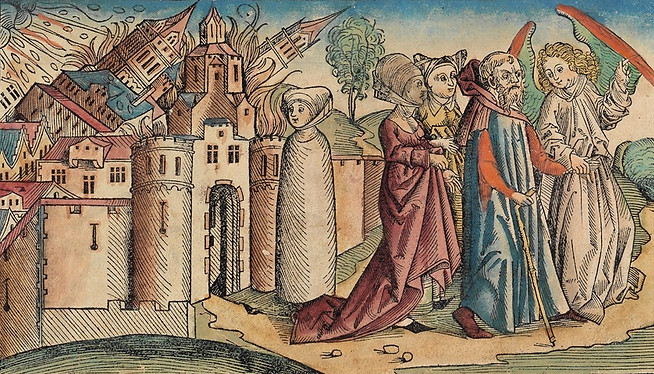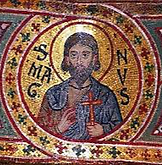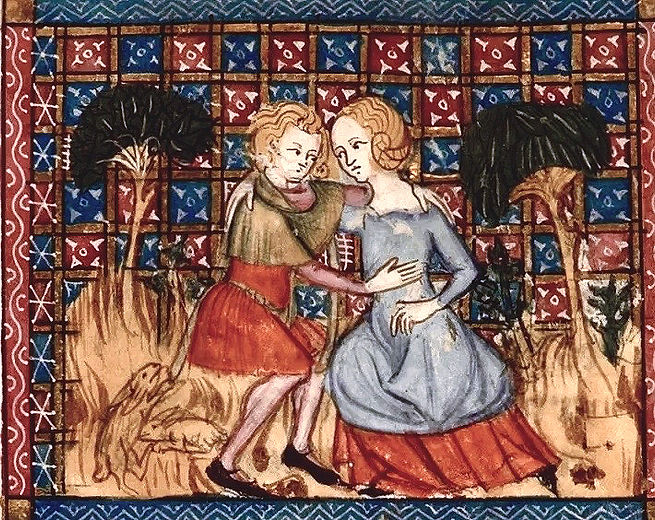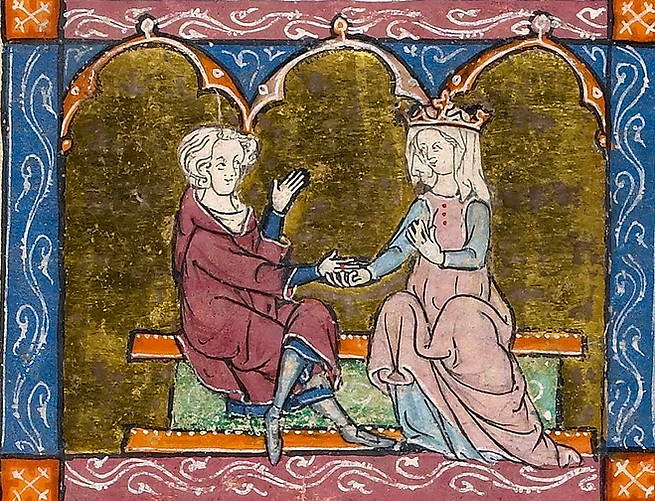Returning Families
"All I am or can be I owe to my angel-mother."
— Abraham Lincoln, private conversation with William Herndon, c.1850
Lincoln's mother died of milk sickness (consumption) when he was nine years old. Later in life he spoke of her with much tenderness and appreciation. According to his longtime law associate and biographer, William Herndon, Lincoln talked to him about his mother only once — in a one-horse buggy on the way to court — which was notably the first and last time they discussed his ancestry. The above citation was immortalised by Herndon in an interview (Cincinnati Commercial, 25 July 1867) two years after Lincoln’s death. While more may be said about his mother and father, as well as his belief in god and guardian angels, we now turn to Lincoln's actual Dhuman family lineage. These lives are set out as clarified by El Ochre and El Aurenx (c.1997, 2025).

The Lives of Lincoln
The lives of Abraham Lincoln can be traced back to Menelaiu, the eldest son of twin-souls Salomaiu and Salome, whose names come down to us via their ancient Atlantean incarnations. The three often reappeared in the same family roles or as members of the same karmic constellation. Our next post (see below) looks at the lives of Salomaiu and Salome from their time in latter-day Atlantis to their role in the Victorian age. We now focus on the relationship between father and son only.
Menelaiu returned as Moab, a legendary ancestor of the Moabites, and the son of Lot (Salomaiu) and his wife (Salome). In the biblical story Moab is the elder son of Lot, pronounced Lud, by incest with his elder daughter. This is fiction. In reality Moab was the eldest son of Lot by his principal wife Uda, also rendered in Jewish tradition as Ada or Edith. She was of course never turned into a pillar of salt. This is merely an allegory used to represent the neutralisation of the Divine Feminine working through Salome:

"The biblical legend of Lot with his wife and daughters is anachronistic in that the original events occurred over two lifetimes in Atlantis. Salomaiu was among the Sons of God, incarnate in the Dhuman-Adamic race of Atlantis who married with the daughters of men. Overcome by the infernal force of lust, he became impervious to the spiritual influence of the Divine Feminine force in his twin-soul, Salome. Her spiritual impotency with regard to him was symbolised as 'a pillar of salt', for in alchemy salt represents the inert neutralisation of polarities. The consequence of all this was his spiritual fall into incest. Thus he had sexual relations with his own daughters, born of his adultery." (El Aurenx, Esoteric Biographies, 1997–2001)
The three would be reunited again during Egypt's Eighteenth dynasty. Unbeknown to official history, Amenhotep was the son of Pharaoh Thutmosis II and Queen Hatshepsut. He was also the half-brother of Thutmosis III (an early incarnation of Thomas Jefferson). Amenhotep rose to become Keeper of the Royal Ark of Amen (Ark of the Covenant), a priestly role later inherited by Moses, otherwise known as Osiraes or Adolemaiu. Significantly, in the biblical account the Ark was carried by the Israelites into the land of Moab where the Covenant was renewed and where, later, Moses died (Deuteronomy 29). The Kingdom of Moab and the Kingdom of Judah lay on opposite sides of the Salt (Dead) Sea,
It is said the Ark was confiscated by Osiraes and his 'brother-priest' Asarharon (an early incarnation of Haroun al-Rashid and Francis Bacon) during the exodus of the Hebrews from Egypt: "The 18th-dynasty priests of Amen misused it in the practice of sorcery to invoke telepathic control over elemental forces and entities belonging to the lower astral plane — and this resulted in phenomena of the kind often seen in shamanism, akin to voodoo or that type of witchcraft which is of ill-repute. However, Osiraes was instructed by inspiration to have the ark modified for other purposes. It was then attuned to psychic-etheric forces of a higher order and became the repository of a special meta-technological device. The radiation transmitted through this instrument could be directed to attune the etheric body of a properly prepared adept to a very high frequency..." (Olipheru, 27 September 2003)

Menelaiu reappeared as Menelik, sole offspring of King Solomon (Salomaiu) and the Queen of Sheba (Salome). She is also known as Bilqis and Makeda. According to tradition, Menelik reclaimed the Ark and brought it back to Egypt, installing it on the island temple of Elephantine until he found sanctuary for it in the Chapel of the Ark at Aksum, then the royal capital, where it allegedly remains to this day. Linked by legend to Ham, youngest son of Noah, the Ethiopians have served as custodians of the Ark. Menelik is ever since the legendary ancestor of the Emperors of Ethiopia.


Menelaiu returned as Lucan (39 – 65 CE), a Roman poet and Republican patriot. Lucan was the nephew of Seneca the Younger (El Eremulu, an early incarnation of John Milton), under whose tutelage he received a Stoic education. The youthful Lucan studied in Athens and showed early promise as a rhetorician and orator, drawing attention to himself back in Rome. He became both a friend and, later, a foe of Nero. Nero resented Lucan's fame and forbade him to recite his poems in public. (Tacitus, Annals XV.49) Disenchanted by Nero's tyranny and embittered by the ban on his recitations, Lucan responded by insulting Nero in poetic form. He was eventually implicated in the Pisonian conspiracy against the emperor and, like his uncle Seneca, executed by forced suicide on Nero's orders. Tacitus adds that Lucan died repeating a passage from one of his poems describing the death of a wounded soldier. He was 26 years old.



When Nero compelled him to commit suicide by opening a vein, Seneca cut his wrists in a bath to quicken his death. Seneca and Lucan both played leading roles in the conspiracy of Gaius Calpurnius Piso. There were at least 41 others involved, 19 of whom were executed or likewise forced to commit suicide, while another 17 were exiled or denigrated. Only 5 were acquitted. Such was the madness of Nero. While Lucan is inextricably linked to Nero, now reincarnte as Trump, this stoical soul is not incarnate today. (El Ochre, 2 April 2025)


Menelaiu and Salomaiu appeared once more as President Lincoln (1809 – 1865) and Colonel Olcott (1832 – 1907). Henry Steel Olcott was a respected journalist, field correspondent and army officer in the American Civil War. After his service in the US Army, Olcott was admitted to the position of Special Commissioner in the War Department (New York) and, later still, promoted to the rank of Colonel in the Navy Department (Washington). He went on to become a lawyer after serving on the commission to investigate Lincoln's assassination. He is better known today as a Buddhist and Theosophist.
In turn, Lincoln is known as a republican patriot and deep-thinking Stoic. His ability to remain steadfast and calm in the face of adversity is seen as an exemplary blend of stoicism and spirituality. He believed the Civil War was God's punishment for the sins of slavery and called on the nation to seek forgiveness. He draws a parallel with Sodom and Gomorrah, unconsciously perhaps, saying sinfulness provokes God's wrath. (Genesis 19) Lincoln certainly knew his Old Testament well, including the story about the Ark of the Covenant, and made his own covenant with God to free the slaves should the Unionists win the Civil War: "I made a solemn vow before God, that if General Lee was driven back from Pennsylvania, I would crown the result by the declaration of freedom to the slaves.” (Civil War Diaries, 1862)
"Historians often speak of the hinges of history, of turning points that shape all that comes afterward. The Emancipation Proclamation was such a turning point, and the fact that it arose from a nation’s leader making a covenant with God to liberate a people is a tale we ought to know, we ought to celebrate, and we ought to commend to the generations that follow us. In doing so, we might help our nation return to the covenant-making God of Abraham Lincoln."
— Stephen Mansfield, Abraham Lincoln and His Covenant with God, 16 February 2024

Like Lucan, Lincoln was a gifted orator. His Gettysburg Address on 19 November 1863 is popularly seen as "one of the most famous, enduring, and historically significant speeches in American history." (Wikipedia) However, his life was cut short once again, this time by assassination.
While Lincoln's natural parents, Nancy Hanks and Thomas Lincoln, should not be confused with his spiritual parents, Salomaiu and Salome, he did see in his mother something of the divine feminine. We shall examine this theme in our next post.
"You were born together, and together you shall be forevermore.
You shall be together when the white wings of death scatter your days.
Ay, you shall be together even in the silent memory of God."
— Kahlil Gibran, The Prophet, 1923
The Lebanese-born poet goes on to say, 'love one another but allow spaces in your togetherness'. He also compares the love between individual souls to the strings of a lute, each alone, while quivering with the same music. Likewise, he adds, grow as the oak trees and cypresses toward the same heavens, but without standing in each others' shadow. His poetic similes aptly convey the twin-soul relationship of Salomaiu and Salome and their transpersonal quest for perennial wisdom and the divine feminine. Their Dhuman-Adamic lineage was disclosed via El Ochre three decades ago and has been amplified for publication on White Lotus Day (8 May 2025). There is no affiliation to Theosophy.


The Lives of Olcott and Blavatsky
Dhuman-Adamic entities are ever paired as male and female twin-souls. In Atlantean times twin-souls always incarnated together until the Sons of God intermarried with the daughters of men (Genesis 6.2) and the Dhuman-Adamic race was adulterated into a hybrid co-Adamic race. Since then twin-souls have been estranged from each other, often leading separate lives. Sometimes they still appeared together to work out the karmic issues required for their eventual reunion. One such twin-soul pair is Salomaiu and Salome whose successive incarnations are presented below, ending with their famed collaboration of Colonel Olcott and Madame Blavatsky.
Salomaiu and Salome
The biblical legend of Lot and his family is an anachronistic narrative in that the original events occurred over two lifetimes in ancient Atlantis. Salomaiu was among the Sons of God who married the daughters of men. Overcome by the infernal force of lust, he became impervious to the spiritual influence of the Divine Feminine force in his twin-soul, Salome. Her spiritual impotency with regard to him has been forever symbolised as 'a pillar of salt', since in alchemy salt represents the inert neutralisation of polarities. The consequence of this was Salomaiu's fall into incest. Thus he had sexual relations with his own daughters, born of his adultery.
Salomaiu and Salome reincarnated in the latter days of Atlantis (c.15 000 BCE) as husband and wife. They were Atlantean Israelites, and he was an ambassador to the rival empire of Sumer. This was the time of the second world war of Atlantis when the Aryan race rose against the Israelites. The Sumerian empire at that time extended from Mesopotamia to the Mediterranean coast of Palestine, and the Sumerians took advantage of the unstable situation by declaring war on Atlantis. Salomaiu, residing in Sodom, was opposed to this and warned them of Atlantis’ superior technology. His words went unheeded. He wanted to return to Atlantis but he had a Sumerian mistress who would not leave with him. Moreover he learnt that the Aryans were now supreme in Atlantis and that the Israelites were under a reign of terror. Therefore he decided to stay. The day came however when the Atlanteans were about to terminate the war with Sumer by abruptly obliterating the cities of Sodom and Gomorrah with nuclear bombs. Salomaiu escaped while Salome, whom he had abandoned, perished in the devastation.

Lot and his Wife
Salomaiu was reincarnate as Lot in the time of the patriarch Abraham (c.1900 BCE). During this life Lot visited the contemporary town occupying the site of the long-vanished Sodom and psychically relived its awful destruction. As part of this initiatic experience, Lot also remembered his ancient adultery and incest as Salomaiu. He now sought to escape Sodom within himself, the infernal force of lust that impeded his spiritual recovery, and hereby expiate his sins. He was as yet unable to regain the grace of the Divine Feminine, and so his twin-soul remained salt in his wounds. Lot and his wife are also known as Lud and Uda.


Zebulun and Dinah
Zebulun was the son of the patriarch Jacob and the concubine Leah. Dinah was his sister, also a daughter of Jacob and Leah. Dinah fell victim to rape (Genesis 34) by a Canaanite, and it was left to her brothers Simon and Levi to avenge her violation. Where was Zebulun, her twin-soul? He must have suffered much anguish but was as guilty as the rapist because of his past-life sins, and was karmically restrained from taking revenge. Dinah means ‘Judgement’ and her awful fate was a judgment upon him. In his next life with her he would enjoy a brief reprieve.
Thothmes and Hatshepsut
Thothmes II (c.1500 BCE) was a pharaoh of Egypt’s 18th dynasty. According to the customary incest of the pharaohs, he married his half sister Hatshepsut, and they were co-rulers. They built official temples at Thebes, Karnak and Luxor to the state cult of the reigning god Amen-Ra. They jointly sponsored the renascence of the ancient Ros-Tau (Rosicrucian) Mystery School at On (today Heliopolis) of which they were both initiates. This was the renewal of the spiritual bond they had once enjoyed as twin-souls in Atlantis. After the death of Thothmes, Hatshepsut kept the crown as pharaoh. Her stepson, Thothmes III, then still a child, became her nominal co-ruler and eventually succeeded his mother upon her death (see The Archons of Arcturus). Unbeknown to official history, Thothmes II had a son by Hatshepsut. Who he was and what became of him has been told in the previous section, The Lives of Lincoln.



Paris and Helen of Troy
In Greek mythology Paris, also called Alexander, was the son of Priam, King of Troy (Winston Churchill). It was foretold that Paris would one day bring ruin upon Troy. Priam therefore had him abandoned on a mountain where he was found and raised by shepherds. Once a fully grown man, he was approached by three goddesses — Hera, Athena and Aphrodite — and asked to judge which one of them was the most beautiful. Each offered him a bribe for his favour: Hera promised him a kingdom, Athena a victory over Greece, and Aphrodite the hand of Helen, the most beautiful woman in the world. Even though he was in love with a nymph, Oenone, and Helen was married to the king of Sparta, Paris favoured Aphrodite. He eventually eloped with Helen, and the Trojan War ensued (c.1200 BCE). When Paris was mortally wounded he sought a magic cure from Oenone, which she denied him. When he died, she killed herself in grief. Following the fall of Troy, Helen was reconciled to her husband. For Paris, this initiatic escapade replayed the dramas of his dilemmas in the latter days of Atlantis — his conflicts of loyalty in love and war. He still owed a karmic debt for his former infidelity and sought the grace of the Divine Feminine.


Solomon and the Queen of Sheba
Solomon (c.1000 BCE) was a son of David by Bathsheba, and the greatest king of Israel. He built the Temple at Jerusalem and was Grand Master of the ancient Masonic Order of Israel. Similarly to Paris, God offered him three options: wealth, glory and wisdom. He chose wisdom but received the others as a boon. Although Solomon lived in splendour and had many wives and children, he enjoyed a legendary reputation for wisdom, so much so that the Queen of Sheba (Bilqis from Ethiopia) sought his counsel. By her he also had a son (see The Lives of Lincoln) who became the ancestor of the Ethiopian Emperors. The ’Song of Solomon’ is an ode to the Queen of Sheba and an allegory of the grace of the Divine Feminine.



Simon Zelotes/Magus and Mary Salome/Helena
Simon Zelotes was one of the twelve apostles of Jesus. His epithet Zelotes meant he had been a Zealot — a member of the militant liberation movement that sought to overthrow the Roman occupation of Palestine. He was in fact Simon of Bethany, alias Lazarus, the brother of Martha and Mary Magdalene. As a candidate for initiation by Jesus, he was styled Simon the Leper as he was to be regenerated through the resurrection from the tomb that ritually enacted the third degree initiation. Significantly, the name Lazarus designated a candidate for this type of initiation. He was thereafter called Simon the Favoured, for his Aramaic epithet Cananaias (Greek: Zelotes) meaning ‘Zealous’, was changed to Ananias (Hebrew: Hananiah) meaning ‘Favoured’. He was the original Faust (Latin: Faustus) meaning ‘Favoured’ too, the only apostle whom Jesus favoured with the third degree initiation of resurrection. He was therefore called ’the disciple whom Jesus loved’ (favoured) according to the Gospel of St John which preserves some of his Gnostic teachings on Jesus.
Following Jesus’ crucifixion, Simon Ananias became the leader of the local Gnostic Essenes. The other apostles remained uninitiated as members of the orthodox Nazarite Essenes, or Nazarenes, headed by James Justus, Jesus’ brother. James’ younger brother Jude (Judas Thomas) supported the Gnostic sect of Simon Ananias, but the others were not recruited because of the impetuous opposition by James’ stalwart, Simon Peter, who rejected Gnosticism which he equated with paganism and sorcery. Simon Ananias and his consort, Mary Salome, were denounced by Peter as ‘playing false to the Holy Spirit’ and were to be excommunicated from the apostolic community by being ritually declared dead. (Acts 5.1–11)

Mary Salome was also called Sapphira (‘Beautiful’) and Helena of Tyre. She was a reincarnation of the beautiful Helen of Troy. Simon Ananias, also called Simon Magus (‘Wise One’), declared that he had ‘redeemed her from harlotry’. This referred to the equivalent female form of the third degree initiation of regeneration, which Jesus had bestowed on Simon of Bethany’s sister, Mary Magdalene, and it signified the redemptiion of the Divine Feminine from the infernal force of lust in man. Peter, who was a misogynist, had no understanding of the Divine Feminine aspect of the Holy Spirit.
Simon Ananias was later baptised by the apostle Philip, indicating his reconciliation with the apostolic community and a revocation of his excommunication by Peter. He again attempted to recruit Peter to the Gnostic initiation, but was again rebuked (Acts 8.9–24). In both cases, money is made the issue of Peter’s accusation of corruption against Simon Ananias, but esoterically money is merely a metaphor for motive. Peter mistrusted Simon Ananias’ motive and could not be persuaded to accept the Gnostic initiation. Simon’s words to Peter (Acts 8.24) should read: ‘Pray that none of what you have said may befall you’.

When Saul of Tarsus began his persecution of the Nazarenes, Simon Ananias and his Gnostic Essenes withdrew to their retreat at Damascus. When he went there in pursuit of them, Saul had his remarkable vision of the risen Christ and saw that he had been spiritually blind. He suffered physical blindness for three days and was restored to sight by Simon Ananias. This experience was a third degree initiation, accompanied by an out-of-body ascension to ’the third heaven’ (2 Corinthians 12.2–4). Saul was thus converted by Ananias to the Gnostic doctrine. Later in his missionary zeal as Paul, he distorted some of the Gnostic teaching. It was, however, Paul’s version of Gnosticism that became Christianity. Peter was eventually reconciled to the Pauline ministry but never overcame his animosity toward Simon Ananias. In the inauthentic apocryphal ‘Acts of Peter’ their final encounter is portrayed as a spiritual duel of magical power. They match each other in performing miracles until, after Simon Magus had levitated himself to a great height, Peter’s prayer brings him crashing down in disgrace and defeat. Thus the Church caricatured the figure of Faust as a false prophet and evil sorcerer, and rejected Gnosticism. But had not Jesus prophesied that ’the stone which the builders reject will be the apex of the Temple’? (Matthew 21.42; Mark 12.10–11; Luke 20.17–18)

Lancelot and Guinevere/Elaine
The Authurian romances recapitulate similar Biblical legends, for many of the biblical characters were reincarnate in the days of King Arthur. King David and Bathsheba were reincarnate as King Arthur and Guinevere. David had betrayed Bathsheba’s husband, Uriah the Hittite, and usurped her as his wife (2 Samuel 11). So it was Arthur’s karma to be betrayed in love by Guinevere. And yet another karmic drama was invested in this. David’s son by Bathsheba, Solomon, was reborn as Lancelot, the greatest of Arthur’s knights in both prowess and virtue. And yet his tragic love for Guinevere would ultimately lead him to betray his loyalty to Arthur.
Like it was in his life as Paris, Lancelot’s innocence was challenged in an initiatic encounter with the enchantress Morgan le Fay. She brought him three queens and bade him choose whom he would have, but Lancelot’s love for Guinevere was such that he would have no other, since he felt that he could not rightfully have her. As Helen was to Paris, so was Guinevere to Lancelot. Indeed Helen, who was to return as the Queen of Sheba, was conjointly reincarnate with Bathsheba as Guinevere. Unlike Paris, however, Lancelot would not usurp the wife of another.
In a later initiatic encounter under Morgan le Fay, Lancelot recognised Guinevere as the incarnation of his twin-soul, personified as Elaine (Helen), and consummated their love. Of this union was born young Galahad, the ideal knight, representing the redemption of the Divine Feminine. Galahad would later prove triumphant in the quest for the enigmatic Holy Grail — the chalice of the Divine Feminine — whereat Lancelot would still fail. Lancelot had at last received the grace of the Divine Feminine, and yet his karma was not altogether expiated. He still had one more test of faith and fidelity to endure in spiritual service to humanity.

Olcott and Blavatsky
Henry Steel Olcott (1832 – 1907), as a reincarnation of Lancelot, stoically accepted the return of his twin-soul, now incarnate as the redoubtable Madame Blavatsky (1831 – 1891). Colonel Olcott was a lawyer, a veteran of the American Civil War and a commissioner-of-inquiry who investigated the assassination of President Lincoln, his son in another life. Olcott subsequently investigated the mediumistic claims of spiritualists, which brought him into association with Helena Blavatsky, the Russian-born psychic who founded the Theosophical Society in 1875, with Olcott as its president.
Helena Blavatsky was anything but beautiful. Corpulent in physique and coarse in character, her appeal lay solely in her commanding presence accented by large hypnotic eyes. She often treated Olcott as a fool, yet his respect for her psychic powers and reverence for her revelations sustained his loyalty to her throughout, despite the vilification to which she was subjected by her enemies. Olcott was gentle, humble and unassuming in his demeanour. His wisdom was subdued, but he was no fool. Encountering his twin-soul in this outwardly unattractive form was, for him, the karmic penance he needed to endure for his ancient transgression against the Divine Feminine. Albeit unknowing, he persevered patiently with her to the end.
Primary source El Aurenx, Esoteric Biographies, c.1997